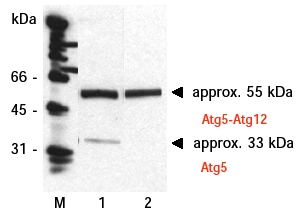ATG5 (incl. pos. control) Mouse Monoclonal Antibody [Clone ID: 11C3]
CAT#: AM20206PU-N
ATG5 (incl. pos. control) mouse monoclonal antibody, clone 11C3, Purified
Other products for "ATG5"
Specifications
| Product Data | |
| Clone Name | 11C3 |
| Applications | WB |
| Recommended Dilution | Immunobotting (Western Blot): 0.5 µg/ml for HRPO/ECL detection. Recommended blocking buffer: Casein/Tween 20 based blocking buffer and blot incubation buffer. Included Postitive Control: Cell lysate from untreated SH-SY5Y cells (See Protocols for more details). |
| Reactivities | Canine, Human, Mouse, Rat |
| Host | Mouse |
| Isotype | IgG1 |
| Clonality | Monoclonal |
| Immunogen | Recombinant ATG5 |
| Specificity | Recognizes the ATG5-ATG12 protein complex at 55 kDa in immunoblot application. |
| Formulation | PBS State: Purified State: Lyophilized purified IgG fraction Stabilizer: PEG and Sucrose Preservative: 0.09% Sodium Azide |
| Reconstitution Method | Restore with 1ml H2O (15 min, RT). |
| Purification | Purified from Serum-Free Cell Culture Supernatant by Subsequent Ultrafiltration and Size Exclusion Chromatography |
| Gene Name | Homo sapiens autophagy related 5 (ATG5), transcript variant 1 |
| Database Link | |
| Background | Autophagy as a response to cellular stress and starvation is an alternative process of proteasomal degradation for some long-lived proteins and organelles. Alterations in the autophagic-lysosomal compartment have been linked to neuronal death in many neurodegenerative disorders as well as in transmissible neuronal pathologies (prion diseases). The gene product of autophagy-related gene 5 (ATG5) is required for autophagosome-formation. ATG5 also enhances the susceptibility towards apoptotic stimuli. Like Bcl-2, ATG5 exhibits a dual function by modulating both autophagy and apoptosis. |
| Synonyms | ASP, APG5-like, Autophagy protein 5 |
| Note | Molecular Weight: 24, 33, 55 kDa Protocol: Positive Control: Cell lysate from untreated SH-SY5Y cells. Formulation: Lyophilized cell lysate from Serum starved SH-SY5Y cells. Stability: Reconstitute by addition of 200 µl H2O. After complete solubilization add 200 µl 2x SDS-PAGE sample buffer, mix and incubate at 90°C for 5 min. Application: The Positive Control lysate is recommended for Immunoblot applications. 20µl of Positive Control correspond to ca. 20.000 cells. Use 20µl/lane (mini gel) for HRPO/ECL detection of the target proteins. Storage: Aliquote and store frozen. Avoid repeated freeze/thaw cycles. Shelf life: one year from despatch. The Lyophilized cell lysates contain SDS and are not recommended for applications with native proteins such as Immunoprecipitation. |
| Reference Data | |
| Protein Families | Druggable Genome |
| Protein Pathways | Regulation of autophagy, RIG-I-like receptor signaling pathway |
Documents
| Product Manuals |
| FAQs |
| SDS |
{0} Product Review(s)
0 Product Review(s)
Submit review
Be the first one to submit a review
Product Citations
*Delivery time may vary from web posted schedule. Occasional delays may occur due to unforeseen
complexities in the preparation of your product. International customers may expect an additional 1-2 weeks
in shipping.






























































































































































































































































 Germany
Germany
 Japan
Japan
 United Kingdom
United Kingdom
 China
China



